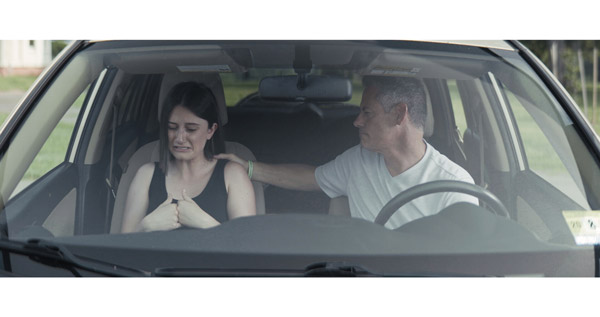
When beginning to craft their film, one of the many decisions a filmmaker must make surrounds the grounding of the film, i.e. how many characters, settings, and scenes their film will contain. Often, one might think a more busy and complex film would be best. However, it can also occur that the more subtle and approachable simpler films can become extremely layered and interesting in their fashion. This principle applies to many films but is especially present in Ezekiel Goodman and Hannah Zipperman’s Sylvia, and Samuel Edelsack’s You Still Can, both films that stray away from a more expansive and grand in scale style and instead turn towards a more intimate style that allows viewers to sit in its presence and characters through its usage of specific dialogue styles, color palettes, and music presence.
Sylvia surrounds a woman in a bar, engaging in a conversation with the bartender. She recalls her desire to have a pet named Sylvia and how a combination of that desire and her husband’s growing emotional distance led to their divorce. Sylvia feels like a dream, with its rich colors, containing one smaller room setting, and inter-spliced dancing moments from the woman herself. Its simplicity allows the viewers to sit with it and better immerse themselves in this quiet and ethereal world. Similar in its more focused approach, You Still Can surround a father, Travis, attempting to stop his estranged daughter, Julia, from committing suicide in an emotional and tender conversation about their past and family. You Still Can guides its audience to remain solely focused on their conversation, with no brief glimpses of the outside world to distract. Both films remain similar in their more defined style in their discussions but differ in their dialogue style.
Sylvia’s dialogue presents itself very similar to almost a monologue, the woman expresses her long tale of her long-term desire to have a pet and a man who stopped paying attention to her with little vocal response and only an engrossed reaction from the bartender she is sharing it with. This writing choice allows audiences to focus solely on the woman and hear her whole story without interruption. In contrast, You Still Can is more of a conversation work, a fitting choice as it focuses viewers on both Julia and Travis in order to learn their story and what led to this conversation. This greatly benefits the audience as the story progresses, we learn how dark their relationship is and one of the contributing factors to the daughter's sadness: the declining health of the mother. Both of these writing decisions push watchers to engage with the important characters and know them best due to their relevance. Additionally, the films differ in their usage of color, signifying the character's current state within their emotions and places in life.
Sylvia features a rich color palette of deep browns, reds, greens, and yellows, enhancing the film’s dream-like look. The woman has escaped her detached husband and has entered a new and vibrant place in her life, one that allows her to explore and fulfill her desires. This new stage and freeness accompany the film’s bold and new colors. In contrast to this, You Still Can’s colors are more muted and dark, representing the sad tone of the piece. Julia herself wears all black, representing her current emotional state. This is contrasted with Travis wearing the opposite, white, symbolizing his attempts to help his daughter. While the films utilize very different color palettes, they both aid the films well in representing the tone and emotions of their characters.

Sylvia and You Still Can both utilize music but in very unique ways. The woman in Sylvia is a dancer, and inter-spliced within the film is her performing a dance to accompany a piano piece played within the film. The piece does not overpower the film’s dialogue or plot but serves to accompany and emphasize the important moments and story pieces within the film. The music combined with the coloring entrances the viewer and leaves them wondering what will happen next. You Still Can’s music component only occurs within the opening scene of Travis finding Julia. The rest of the scenes and films include no music, implementing a more naturalistic style that allows the characters and their words to breathe and be best taken in by the viewer and feel the emotions within the conversation. You Still Can includes important moments of silence between Travis and Julia, and these moments must be felt by the audience in order for them to best understand the film. While the two films' music usage differs greatly, Goodman, Zipperman, and Edelsack all utilize music and sound unique in a way that enhances both films greatly.











